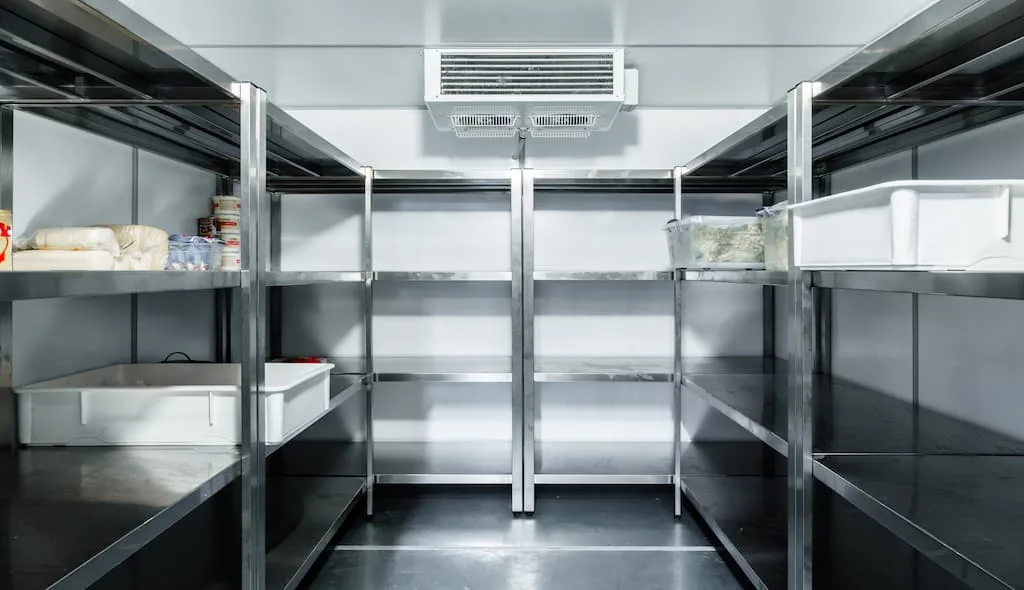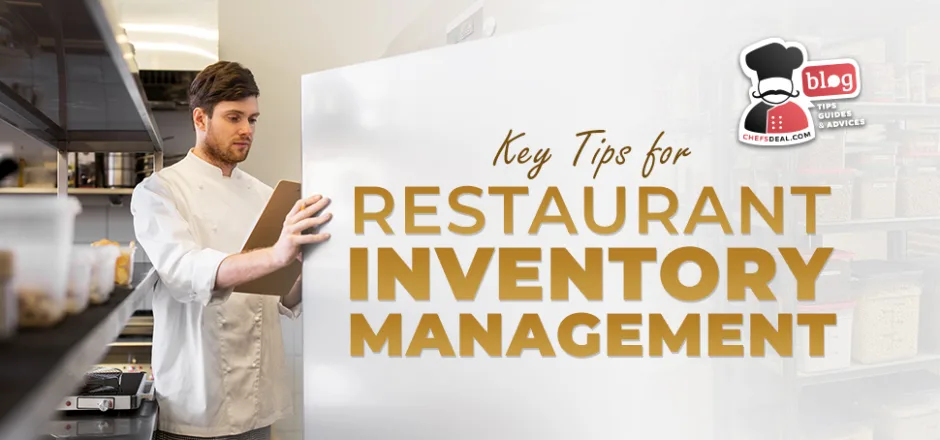Restaurant inventory management is key to a restaurant’s success because proper inventory management boosts kitchen productivity and profitability and prevents food wastage. Making a comprehensive inventory management plan to track, manage, and enhance the restaurant inventory ensures efficiency and smooth operation in commercial kitchens. Monitoring and tracking the stocks, forecasting demand, recipe management, and waste reduction are some restaurant inventory management tips to ensure a flawless operation. Whether you’re a seasoned restaurateur or just starting, this guide will illuminate the nuances of managing your inventory efficiently.
What is Restaurant Inventory Management?
Restaurant inventory management is keeping track of the current inventory your business has. Inventory management provides data on the amount and sort of purchased inventory, your daily used inventory, and leftover inventory for each day. This information allows restaurants to improve purchasing and reduce inventory losses by preventing food spoilage and waste.
Restaurant inventory management can be done by manual counting and spreadsheets. However, inventory management software makes the process easier and ensures accuracy in counting and tracking the items. It can also provide key financial and performance data and additional features such as automated reorder point purchases.
The inventory of a restaurant typically consists of the following:
- Dry Products
- Perishables
- Beverages
- Spices
- Cooking Equipment
- Worker Uniforms
6 Key Tips for Restaurant Inventory Management
Managing your inventory takes time and effort, but when done properly, you can reduce food waste, create an organized kitchen, and boost profits. We have listed 6 basic yet essential tips to establish proper and efficient restaurant inventory management.
- Planning and Organizing
- Monitoring Stock
- Using an Inventory Management Software
- Forecasting Tools and POS System
- Maintaining a Schedule
- Using Stock Efficiently
1. Planning And Organizing
Making a plan is the first step in establishing proper restaurant inventory management in all aspects of a successful business. Organizing old inventory before purchasing new stock is essential to prevent redundant stock and food waste and ensure freshness. Holding costs, which include storage, insurance, and potential product spoilage or obsolescence, typically represent about 25% of a restaurant’s inventory value on hand.
Some stock control tips include organizing storage shelves, labeling products with expiration dates, and using the FIFO (first in, first out) method. FIFO is an accounting method in which the first bought is used or disposed of. Organizing products by dividing shelves into sections for different items, using labels, and keeping track of goods by keeping records are some ideas to provide easy access to employees and keep the operation flawless.

2. Monitoring Stock
Keeping track of the goods on a daily basis is essential to making a stock plan, depending on your daily usage. By tracking restaurant inventory, you can identify the time and amount of purchasing goods that will ensure significant food items are not out of stock when needed or expired. It will also prevent overstocking and food waste, reducing the kitchen costs.
With proper inventory management, you can predict what items will run out depending on usage density and have a backup ready. Knowing how much product is needed for a dish will determine the stock orders. On the other hand, ordering more than necessary causes food waste in most commercial kitchens. After keeping track of your inventory and making daily reports, you can make a monthly inventory report by hand or using restaurant inventory management software.

3. Using an Inventory Management Software
As of 2020, studies have shown that around 68% of restaurants utilize some form of inventory management software, reflecting its growing importance in the industry. A restaurant software or inventory software helps greatly inefficient inventory management. Inventory management software can automate purchases by making orders based on specified reorder points and sales patterns.
Another benefit of inventory software is that it can calculate recipe costs based on ingredient prices, portion quantities, and items on the menu. It provides information on each dish’s profitability, which helps in menu optimization and price decisions. Using this software, you can calculate the yield of each product and provide useful information for better cost management.
4. Forecasting Tools and POS System
Forecasting tools help restaurants to detect trends and adapt as quickly as possible. Forecasting based on your past data provides insight into the two most essential costs: food and labor. Based on previous sales data, trends, and market research, forecasting tools can foresee important points such as predicted sales, customer traffic, and menu item purchases.
Restaurant POS systems can also help in restaurant inventory management. Cloud-based POS are the most popular since they have extra features and options and are less expensive. Pos systems may provide sales estimates to help enlarge your campaign’s email audience.
When integrated, a POS system can automatically deduct items from the inventory as they’re sold, giving real-time updates on stock levels. This synchronization ensures that restaurant managers can quickly identify when stock is running low and make timely reorder decisions.
Furthermore, advanced POS systems can analyze sales data to provide insights into inventory turnover, best-selling items, and items that aren’t moving as expected. This data not only aids in making informed purchasing decisions but also in tweaking menu offerings based on what’s popular or cost-efficient. This integration is invaluable for restaurants aiming for efficiency. It eliminates manual inventory tracking, reduces human error, and ensures a seamless flow between front-of-house sales and back-of-house stock management.
5. Maintaining a Schedule
Following a schedule lets you know how many ingredients and food items you utilize over a specific period. Perishables and most used items can be counted daily, while bulk products and non-perishables can be counted once or twice weekly. You will begin to notice patterns over time and can change your orders or menu options as needed.
6. Using Stock Efficiently
Food waste is one of the biggest expenses of a food service business, affecting the profitability of the operation and causing money waste. You can use your stock more efficiently and eliminate waste with restaurant inventory management and with some tips given below.
- Keeping restaurant inventory, especially perishables, at a minimum will reduce wastages, but make sure to have enough considering your menu and with the help of forecasting tools.
- Using seasonal products is a good idea for all time. You can use them for seasonal specialty dishes and design your menu seasonally. It will avoid food waste and attract clients with something new on your menu.
- Setting a reorder level for goods ensures you don’t run out. You can set a specific reorder level for each product that will remind you to reorder it when it hits the level you have set with an email. Real-time alerts are useful to remind the most used products and perishables that must be refilled regularly. It will ensure you don’t run out of stock during operation hours, which may cause unpleasant predicaments, and also help reduce waste.
- Make sure to use the FIFO, which employs a stock rotation method. In this method, the item bought first is used by arranging the products by their expiration dates from the earliest to the latest. This simple yet efficient method will help prevent food waste, and the staff will be aware of the expired items.
- Food waste does not only occur in the back of the kitchen. You may be throwing the bulk of untouched dishes away at the end of the day, showing that your portions are too much. Over-portioning is another way of food waste in commercial kitchens. Effective portion control allows you to extend your food budget while maintaining quality. It may not be possible to fully eliminate food waste, but you can reduce it considerably by simply taking some precautions.

How To Take Inventory?
Inventory can be taken differently depending on the size and kind of your restaurant. Here is a simple explanation of taking inventory:
- Make a Table: Make a top-to-bottom inventory table with five columns. Label the columns with the following terms: item, measurement unit, present count, unit price, and total cost.
- Make a List of Products: List each item in a separate row on the inventory table. You can group related products, such as all diaries.
- Save The Amount: Record the number or volume of a product using a proper unit of measurement. For instance, you can list buns by pound or by the number of 10-pound boxes.
- Highest Cost: Keep track of the unit cost of each item in the inventory. Do not forget to enter the most recent price you bought the item to know the recent price of the products and the costs of restocking.
- Calculate The Cost: Multiply the inventory number by unit and the item’s latest price. Put that number in the total cost column.
- Par Inventory Sheet: The bare minimum level of each product you want on hand is the “par” level. A par inventory sheet outlines how much of a particular item the restaurant always wants on hand and when it should be replenished.
Benefits of Restaurant Inventory Management
Effective Expenditure Control: Restaurant inventory management allows businesses to control their expenditures efficiently. By monitoring and reviewing inventory levels, operators can identify areas of excessive spending, eliminate food waste, and enhance purchase selections. As a result, it will boost the profitability of the business.
Uninterrupted Service: You can continually offer menu items to customers by maintaining proper inventory levels without running out of vital supplies, dissatisfying customers, and losing potential revenue.
Flawless Operation: Restaurant inventory management provides an organized environment and important information about the available stock, streamlining operations. You can better arrange purchases, production, and menu options with a precise knowledge of your inventory. It eliminates rushes or delays in service, providing effective operation.
Customer Satisfaction: Effective inventory management ensures that restaurants can promptly fulfill customer requests, reduce out-of-stock situations, and preserve the consistency and quality of menu items, leading to better dining experience and customer satisfaction.
Accuracy In Financial Reporting: On average, the restaurant industry’s COGS lies between 28-35%. Efficient inventory management can help optimize this percentage, ensuring profitability. Proper restaurant inventory management helps produce reliable financial reports. It enables businesses to track their cost of goods sold (COGS), inventory turnover rates, and financial success. This data aids in deciding on menu prices and understanding profit margins.
Compliance With Laws: Effective inventory management ensures your business complies with laws and regulations for food safety. Assuring that perishable products are kept at proper temperatures, expiration dates are observed, and inventory can be tracked in a product’s recall or quality control issue.
Conclusion
Conclusively, mastering restaurant inventory management is pivotal for operational efficiency and the establishment’s overall profitability. Consider integrating advanced inventory methods with the best commercial kitchen equipment available to optimize your restaurant’s operations. With the right strategies and tools, restaurants can achieve a seamless, cost-effective, and customer-pleasing experience.
The intricate management of a restaurant’s inventory is pivotal to its overall operational success. Leveraging modern tools, from specialized software to integrated POS systems, allows restaurateurs to maintain a pulse on their stock levels, optimize costs, and ensure customer satisfaction. Embracing these strategies guarantees the freshness and availability of menu items and fortifies the establishment’s financial health. In the dynamic world of food service, a proactive approach to restaurant inventory management is the secret ingredient to culinary and commercial success.






